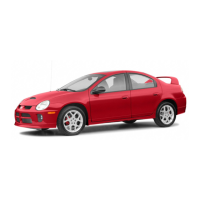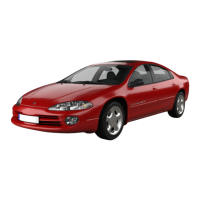variations in inflation pressure can produce inaccu-
rate wheel speed signals; however, the system will
continue to function when using the correct factory
mini-spare.
3.2 ABS DIAGNOSTIC TROUBLE CODES
The Teves Mark 20e Antilock Brake System
(ABS) module may report any of the following
diagnostic trouble codes:
• BUS System Communication Failure
• CAB Internal Failure
• Cluster Lamp Failure
• Left Front Sensor Circuit Failure
• Left Front Wheel Speed Signal Failure
• Left Rear Sensor Circuit Failure
• Left Rear Wheel Speed Signal Failure
• Pump Circuit Failure
• Right Front Sensor Circuit Failure
• Right Front Wheel Speed Signal Failure
• Right Rear Sensor Circuit Failure
• Right Rear Wheel Speed Signal Failure
• System Over Voltage
• System Under Voltage
• Valve Power Feed Failure
Diagnostic trouble codes are retained in memory
until erased using the DRBIIIt, or automatically
erased after 255 key cycles or 3500 miles.
3.2.1 SYSTEM INITIALIZATION
System initialization starts when the key is
turned to “run”. At this point, the CAB performs a
complete self-check of all electrical components in
the antilock brake systems. The ABS and brake
warning lamps will illuminate for 4 seconds with
ignition on.
At 20 km/h (12 mph) a dynamic test is performed.
This will momentarily run the pump/motor. If dur-
ing the dynamic test, the brake pedal is depressed,
the driver may feel the test through brake pedal
pulsations. This is a normal condition.
If any component sets a trouble code during
system initialization or dynamic check, the CAB
will illuminate the ABS warning lamp.
3.2.2 DIAGNOSTIC MODE
For a Mark 20e system to enter diagnostic mode,
vehicle speed must be below 10 km/h (6 mph) and
no ABS condition present. If vehicle speed is not
below 10 km/h (6 mph), a “no response” message
could be displayed by the DRBIIIt. The following
are characteristics of diagnostic mode:
• The amber ABS and red brake warning indicator
will blink rapidly. If a hard trouble code is
present, such as a CAB Power Feed Circuit
diagnostic trouble code, the indicator will be
illuminated without blinking until the diagnostic
trouble condition is corrected.
• Antilock operation is disabled.
3.2.3 INTERMITTENT DIAGNOSTIC
TROUBLE CODES
If the malfunction is not present while perform-
ing a test procedure, the diagnostic procedures will
not locate the problem. In this case, the code can
only suggest an area to inspect. Check for the
following:
• loose or corroded conditions
• damaged components (sensors, tone wheels)
• damaged wiring
• excessive axle shaft runout
• hydraulic system leaks
• foundation (non-ABS) brake system problems
If no obvious problems are found, erase diagnostic
trouble codes and, with the key on, wiggle the wire
harness and connectors. Recheck for codes periodi-
cally while working through the system. This pro-
cedure may uncover a difficult to locate malfunc-
tion.
3.3 FREEZE FRAME
Freeze Frame takes a ‘‘snapshot’’ of specific vehi-
cle information the instant an ABS failure is recog-
nized and stores this information into the CAB
memory. This information can be accessed using the
DRBIIIt to help diagnose the fault. Freeze Frame
will capture the first time failure or only a new
failure that occurs duringthe current ignition cycle.
3.4 USING THE DRBIIIT
Refer to the DRBIIIt user’s guide for instructions
and assistance with reading diagnostic trouble
codes, erasing diagnostic trouble codes and other
DRBIIIt functions.
3.5 DRBIIIT ERROR MESSAGES
Under normal operation, the DRBIIIt will dis-
play one of only two error messages:
– User-Requested WARM Boot or User-
Requested COLD Boot
4
GENERAL INFORMATION

